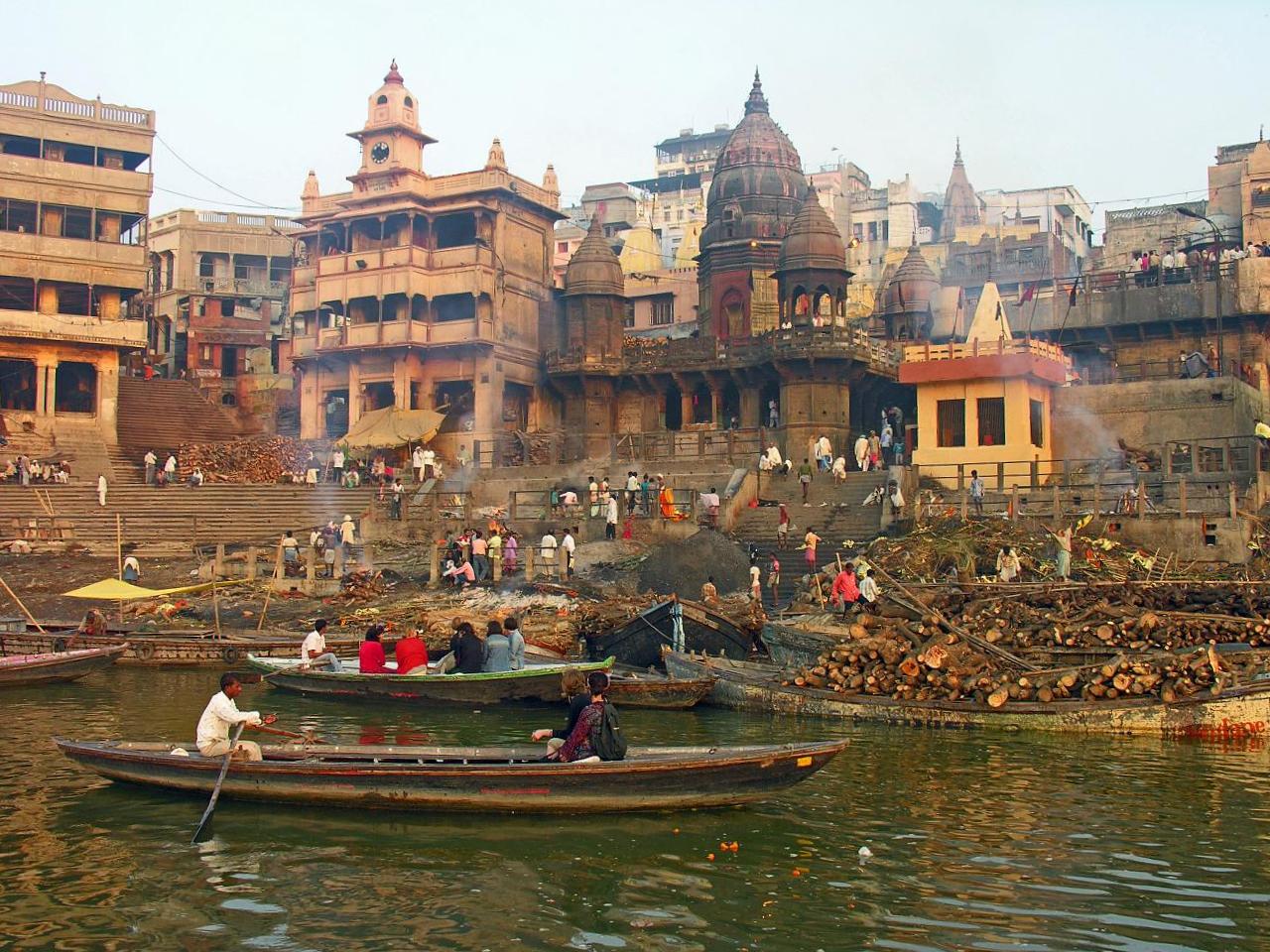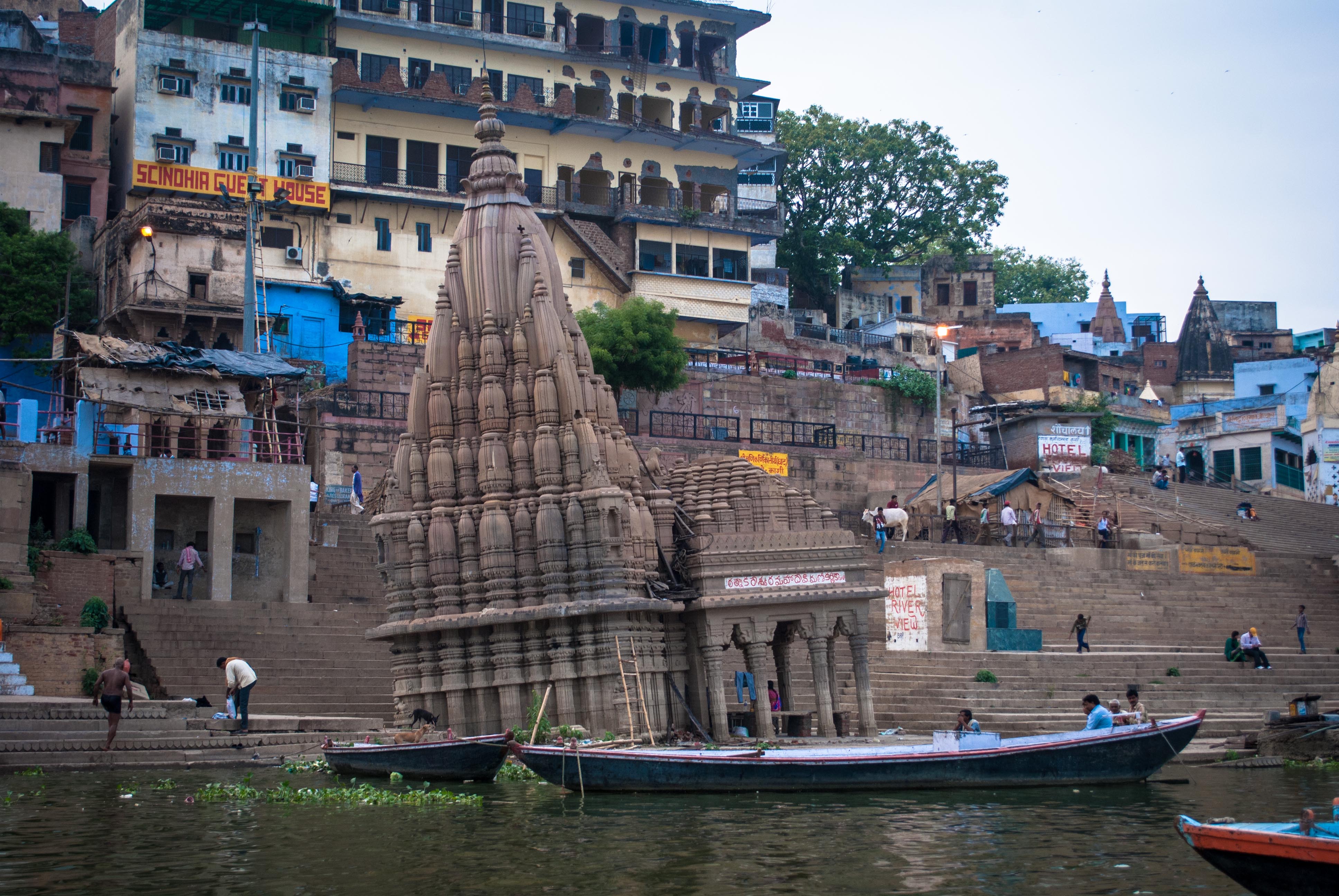Manikarnika Ghat on:
[Wikipedia]
[Google]
[Amazon]
 Manikarnika Ghat (
Manikarnika Ghat (
 The Manikarnika Ghat is one of the oldest ghats in Varanasi. It is mentioned in a Gupta inscription of 5th century. It is revered in Hindu religion. When Mata Sati (Adi Shakti) sacrificed her life and set her body ablaze after Raja Daksh Prajapati (one of the sons of Lord Brahma) tried to humiliate Lord Shiva in a Yagya practiced by Daksh, Lord Shiva took her burning body to the
The Manikarnika Ghat is one of the oldest ghats in Varanasi. It is mentioned in a Gupta inscription of 5th century. It is revered in Hindu religion. When Mata Sati (Adi Shakti) sacrificed her life and set her body ablaze after Raja Daksh Prajapati (one of the sons of Lord Brahma) tried to humiliate Lord Shiva in a Yagya practiced by Daksh, Lord Shiva took her burning body to the
 The Manikarnika shrine is an important place of worship for
The Manikarnika shrine is an important place of worship for
 The well at the ghat is called Manikarnika Kund and was built by Lord Vishnu.
The well at the ghat is called Manikarnika Kund and was built by Lord Vishnu.
File:Weeks_Edwin_Lord_The_Last_Voyage.jpg, Edwin Lord Weeks (1849 – 1903), The Last Voyage, 1884
File:Edward_Lear_-_Benares_-_Google_Art_Project.jpg, Edward Lear (1812–1888) Cityscape, 1873
File:Image from page 446 of "The history of the world; a survey of a man's record" (1902) (14767857492).jpg, The history of the world; a survey of a man's record" (1902) Illustration
File:Eve Of The Eclipse Of The Moon 25th November 1825 by James Prinsep.jpg, Eve Of The Eclipse Of The Moon 25 November 1825, Litograph by James Prinsep
File:Bathing_Ghat_Banaras_India_1890.jpg, Picturesque India. A handbook for European travellers, J. Pedder (1850-1929), 1890
 Manikarnika Ghat (
Manikarnika Ghat (Hindi
Hindi ( Devanāgarī: or , ), or more precisely Modern Standard Hindi (Devanagari: ), is an Indo-Aryan language spoken chiefly in the Hindi Belt region encompassing parts of northern, central, eastern, and western India. Hindi has been ...
: मणिकर्णिका घाट) is one of the holiest cremation grounds among the sacred riverfronts (ghat
Ghat, a term used in the Indian subcontinent, depending on the context could refer either to a range of stepped hills with valleys (ghati in Hindi), such as the Eastern Ghats and Western Ghats; or the series of steps leading down to a body of ...
s), alongside the river Ganges
The Ganges ( ) (in India: Ganga ( ); in Bangladesh: Padma ( )). "The Ganges Basin, known in India as the Ganga and in Bangladesh as the Padma, is an international river to which India, Bangladesh, Nepal and China are the riparian states." is ...
, in the city of Varanasi
Varanasi (; ; also Banaras or Benares (; ), and Kashi.) is a city on the Ganges river in northern India that has a central place in the traditions of pilgrimage, death, and mourning in the Hindu world.
*
*
*
* The city has a syncretic t ...
in the Indian state
India is a federal union comprising 28 states and 8 union territories, with a total of 36 entities. The states and union territories are further subdivided into districts and smaller administrative divisions.
History
Pre-indepen ...
of Uttar Pradesh
Uttar Pradesh (; , 'Northern Province') is a state in northern India. With over 200 million inhabitants, it is the most populated state in India as well as the most populous country subdivision in the world. It was established in 1950 ...
. In Hinduism
Hinduism () is an Indian religion or '' dharma'', a religious and universal order or way of life by which followers abide. As a religion, it is the world's third-largest, with over 1.2–1.35 billion followers, or 15–16% of the global p ...
, death is considered a gateway to another life marked by the result of one's karma
Karma (; sa, कर्म}, ; pi, kamma, italic=yes) in Sanskrit means an action, work, or deed, and its effect or consequences. In Indian religions, the term more specifically refers to a principle of cause and effect, often descriptivel ...
. It is believed that a human's soul attains moksha
''Moksha'' (; sa, मोक्ष, '), also called ''vimoksha'', ''vimukti'' and ''mukti'', is a term in Hinduism, Buddhism, Jainism and Sikhism for various forms of emancipation, enlightenment, liberation, and release. In its soteriologic ...
, and hence breaks the cycle of rebirth when cremated here. Thus, scores of the elderly across the whole country seek to walk up to its edges, and spend their last days absorbing the charisma of the ghat making death painless and insignificant to be pondered upon.
The ghat is named after Sati
Sati or SATI may refer to:
Entertainment
* ''Sati'' (film), a 1989 Bengali film by Aparna Sen and starring Shabana Azmi
* ''Sati'' (novel), a 1990 novel by Christopher Pike
*Sati (singer) (born 1976), Lithuanian singer
*Sati, a character in ''Th ...
's earrings which fell here. The Hindu genealogy registers at Varanasi are kept here.
Location
The Manikarnika Ghat is flanked by the Dashashwamedh Ghat and the Scindia Ghat. It is situated inVaranasi
Varanasi (; ; also Banaras or Benares (; ), and Kashi.) is a city on the Ganges river in northern India that has a central place in the traditions of pilgrimage, death, and mourning in the Hindu world.
*
*
*
* The city has a syncretic t ...
, Kashi region, India
India, officially the Republic of India (Hindi: ), is a country in South Asia. It is the seventh-largest country by area, the second-most populous country, and the most populous democracy in the world. Bounded by the Indian Ocean on the so ...
.
Mythological origin
 The Manikarnika Ghat is one of the oldest ghats in Varanasi. It is mentioned in a Gupta inscription of 5th century. It is revered in Hindu religion. When Mata Sati (Adi Shakti) sacrificed her life and set her body ablaze after Raja Daksh Prajapati (one of the sons of Lord Brahma) tried to humiliate Lord Shiva in a Yagya practiced by Daksh, Lord Shiva took her burning body to the
The Manikarnika Ghat is one of the oldest ghats in Varanasi. It is mentioned in a Gupta inscription of 5th century. It is revered in Hindu religion. When Mata Sati (Adi Shakti) sacrificed her life and set her body ablaze after Raja Daksh Prajapati (one of the sons of Lord Brahma) tried to humiliate Lord Shiva in a Yagya practiced by Daksh, Lord Shiva took her burning body to the Himalaya
The Himalayas, or Himalaya (; ; ), is a mountain range in Asia, separating the plains of the Indian subcontinent from the Tibetan Plateau. The range has some of the planet's highest peaks, including the very highest, Mount Everest. Over 100 ...
. On seeing the unending sorrow of Lord Shiva, Vishnu sent the Divine chakra to cut the body into 51 parts, which then fell to earth. These are called "Ekannya Shaktipeeth". Lord Shiva established Shakti Peeth wherever Sati's body had fallen. Mata Sati's ear ornament fell at Manikarnika Ghat.
The Manikarnika shrine as a Shakti Peeth
 The Manikarnika shrine is an important place of worship for
The Manikarnika shrine is an important place of worship for Shaktism
Shaktism ( sa, शाक्त, , ) is one of several major Hindu denominations, wherein the metaphysical reality is considered metaphorically a woman and Shakti ( Mahadevi) is regarded as the supreme godhead. It includes many goddesses, al ...
sect of Hinduism. It is near to the Kashi Vishwanath Temple. ''The mythology of Daksha yaga and Sati's self immolation'' is the mythology behind the origin of Shakti Peethas. The etymology of the place is due to this mythology. It is believed that Sati Devi's Ear Rings has fallen here. Manikarna in Sanskrit means Ear Rings.
Shakti Peethas are shrines that are believed to be enshrined with the presence of Shakti due to the falling of body parts of the corpse of Sati
Sati or SATI may refer to:
Entertainment
* ''Sati'' (film), a 1989 Bengali film by Aparna Sen and starring Shabana Azmi
* ''Sati'' (novel), a 1990 novel by Christopher Pike
*Sati (singer) (born 1976), Lithuanian singer
*Sati, a character in ''Th ...
Devi, when Lord Shiva
Shiva (; sa, शिव, lit=The Auspicious One, Śiva ), also known as Mahadeva (; ɐɦaːd̪eːʋɐ, or Hara, is one of the principal deities of Hinduism. He is the Supreme Being in Shaivism, one of the major traditions within Hindu ...
carried it and wandered. There are 51 Shakti Peeth linking to the 51 letters or akshar in Sanskrit. Each temple have shrines for Shakti
In Hinduism, especially Shaktism (a theological tradition of Hinduism), Shakti (Devanagari: शक्ति, IAST: Śakti; lit. "Energy, ability, strength, effort, power, capability") is the primordial cosmic energy, female in aspect, and r ...
. The Shakti of Manikarnika is addressed as Vishalakshi & Manikarni.
Significance
Hindu mythology teaches that the ghat is especially sacred and that people cremated there receivemoksha
''Moksha'' (; sa, मोक्ष, '), also called ''vimoksha'', ''vimukti'' and ''mukti'', is a term in Hinduism, Buddhism, Jainism and Sikhism for various forms of emancipation, enlightenment, liberation, and release. In its soteriologic ...
.
As the myth goes, Vishnu, after several thousand years of tapasya, trying to please Shiva, to convince him to not destroy the holy city of Kashi when he destroys the world, managed to do so.
Lord Shiva along with Parvati came to Kashi before Vishnu to grant him his wish. Vishnu dug a kund (well) on the bank of Ganges for the bath of the couple. When Lord Shiva was bathing a Mani (Jewel) from his earring fell into the kund, hence the name Manikarnika (Mani:Beads Karnam:Ear Angad: Ornament). There is another myth about the ghat : the ear jewel from lord Shiva fell down while he was dancing angrily, which fell on the earth and thus Manikarnika Ghat formed.
Manikarnika Kund
 The well at the ghat is called Manikarnika Kund and was built by Lord Vishnu.
The well at the ghat is called Manikarnika Kund and was built by Lord Vishnu.
Proposal
A proposal for renovating the Manikarnika ghat has been proposed by Departments of Landscape Architecture at the University of Illinois at Urbana, Champaign (UIUC), USA, and Bhanubhen Nanavati College of Architecture for Women (BNCA), Pune, India A proposal for renovating and redevelopment the Manikarnika ghat is in progress by Eastern Infrastructure Fund of Varanasi, India.See also
*Ratneshwar Mahadev temple
Ratneshwar Mahadev Mandir (also known as Matri-rin Mahadev, or ''Leaning temple of Varanasi'') is one of the most photographed temples in the holy city of Varanasi in Uttar Pradesh, India. The temple, while apparently well-preserved, leans sign ...
*Ghats in Varanasi
Ghats in Varanasi are riverfront steps leading to the banks of the Ganges river. The city has 88 ghats. Most of the ghats are bathing and puja ceremonial ghats, while two ghats, Manikarnika and Harishchandra, are used exclusively as crema ...
* Dom, an ancient community that handles cremation
Manikarnika Ghat in art
References
{{commonscat Ghats in Varanasi